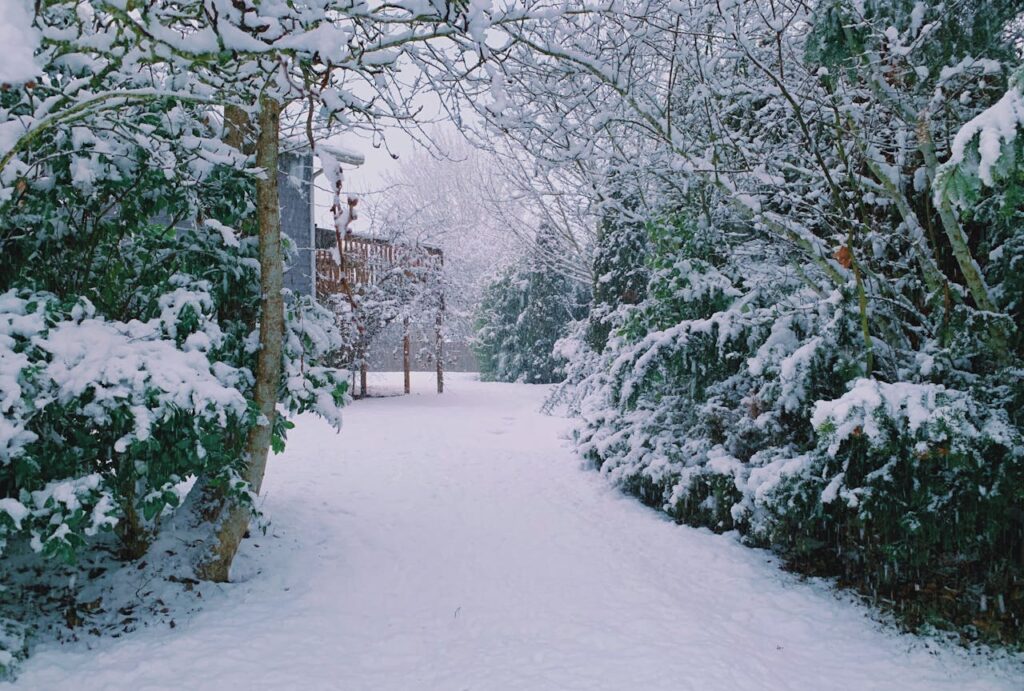
Winter brings its charm with snow-covered landscapes and the festive spirit. However, it also demands diligent preparation to ensure your home and surroundings remain safe and accessible. Snow clearing is essential to winter home maintenance, and embracing sustainable practices can help minimize environmental harm while keeping your property functional. Preparing your new home for a green winter is not only about protecting the environment; it’s also about adopting efficient methods that make the season manageable. Here’s how to gear up for a sustainable snow clearing.
Understanding the Environmental Impact of Traditional Snow Removal
Traditional snow clearing methods can have significant environmental consequences. Gas-powered snow blowers contribute to greenhouse gas emissions, and chemical deicers often contain harmful ingredients that seep into the soil and nearby water sources. These substances can harm plants, aquatic life, and even the foundations of buildings. Piling snow in random spots without planning can create runoff issues that exacerbate flooding during the spring thaw. By shifting to eco-friendly alternatives, you can avoid these negative impacts while maintaining the safety and usability of your property.
Prioritizing Snow Clearing Tools with Low Environmental Impact
The tools you use for snow clearing play a significant role in sustainability. Consider swapping gas-powered snow blowers for electric ones or opting for manual push plows. These tools are quieter and more energy-efficient and reduce your carbon footprint. An ergonomic shovel made from recycled materials can do the job efficiently while being gentle on your body for smaller areas. High-quality tools built to last also save you money in the long run and reduce the waste associated with frequent replacements. The upfront investment in eco-friendly equipment can make a big difference in the environmental impact of your winter maintenance routine.
Exploring Alternatives to Chemical Deicers
Chemical deicers may be effective at melting ice, but their long-term damage to the environment is undeniable. Many contain chloride, which can corrode metal, damage concrete, and harm plant life. Instead of traditional deicers, consider using sand, wood ash, or organic ice melts. Sand provides excellent traction and is easily swept away once the snow melts. Wood ash, a natural byproduct of burning firewood, can also provide traction and help ice melt faster due to its dark color, which absorbs sunlight. Organic ice melts from biodegradable ingredients, offering an eco-friendly solution for icy surfaces, keeping your pathways safe without harming the environment.
Planning for Snow Management Before Winter Arrives
Preparation is key when it comes to snow management. Before winter sets in, evaluate your property to identify areas prone to heavy snow accumulation. Pay attention to driveways, walkways, and outdoor staircases, as these are often the most problematic spots. Installing snow fences can help direct snow away from high-traffic areas. These fences are particularly useful in open areas where wind causes snowdrifts. Ensure that gutters are cleared of leaves and debris to allow for proper drainage during the thaw. When planning for winter, it’s also a good idea to stock up on eco-friendly supplies like organic deicers and snow-clearing tools so you’re not caught off guard by an early snowstorm.
Insulating Outdoor Spaces for Winter Efficiency
Snow accumulation can affect your home’s energy efficiency. Cold air entering through poorly insulated areas increases heating costs and impacts your home’s comfort levels. Make sure that windows and doors are sealed tightly with weatherstripping or caulking to prevent drafts. If you have an outdoor patio or deck, consider covering it with a protective tarp to reduce snow buildup. Insulating your garage and other outdoor storage areas can protect tools and equipment from damage due to freezing temperatures. Proper insulation makes your home more energy-efficient and ensures that outdoor spaces are functional throughout winter.
Green Strategies for Dealing with Excess Snow
Managing large amounts of snow can be challenging, but there are sustainable ways to deal with it. Instead of piling snow in random locations, consider its potential uses. Snow can be used as insulation for garden beds, protecting plants and soil from extreme cold. It can also be strategically placed to create windbreaks around your property. Avoid pushing snow onto public roads or into waterways, as this can lead to blockages and contamination. Think creatively about snow disposal, and remember that what may seem like a nuisance can often be repurposed for beneficial uses.

Choosing Plants and Landscaping That Support Snow Management
Landscaping plays an important role in snow management. Native plants and shrubs can act as natural windbreaks, reducing snow drift in open areas. Choose evergreens or hardy shrubs that can withstand heavy snow without sustaining damage. For your driveway and walkways, consider using permeable paving materials. These allow water from melted snow to seep into the ground rather than run off into storm drains, reducing the risk of flooding. Designing your landscape with snow management in mind ensures that your property remains functional and aesthetically pleasing during winter.
Safety Considerations When Moving Into a Snowy Climate
Following safety rules for moving is crucial if you’re relocating to a region known for heavy snowfall. Ensure driveways and entryways at your old and new homes are clear of ice to prevent slips and falls. Keep pathways well-lit for visibility, especially if you’re unloading items in the evening. Protect fragile items from freezing temperatures by using insulated coverings. Plan your move carefully to avoid mishaps while relocating, especially during snowstorms. Hiring professional movers with experience in winter conditions can help ensure a smooth and safe transition to your new home.
Community Involvement in Sustainable Snow Clearing
Snow management isn’t just a personal responsibility—it’s a community effort. Joining forces with your neighbors can make snow clearing more efficient and sustainable. Consider pooling resources for shared equipment, such as electric snow blowers or communal sand supplies. Organize neighborhood snow-clearing initiatives to ensure walkways and shared spaces are safe for everyone. By fostering a sense of community, you contribute to a safer and greener environment while building stronger connections with your neighbors.
Evaluating and Improving Your Snow Management Plan
Sustainability is an ongoing journey, and there’s always room for improvement. After your first winter, take time to assess your snow-clearing efforts. Were there areas where snow piled up more than expected? Did any tools or methods fall short of your needs? Reflecting on your experience allows you to fine-tune your approach for the next season. Research new eco-friendly tools or techniques that might work better for your property. Keeping an open mind and a willingness to adapt ensures that your snow management practices continue to evolve in a sustainable direction.

Embracing a Green Winter Mindset
Sustainable snow clearing is not just about the methods you use—it’s about adopting a mindset that prioritizes environmental responsibility. Every small change you make, whether it’s choosing eco-friendly tools or rethinking snow disposal, contributes to a larger goal of protecting the planet. By preparing your home for a green winter, you’re safeguarding your property and setting an example for others in your community. Sustainable snow clearing demonstrates that even during the coldest months, you can make choices that positively impact the world around you.
Conclusion
Adopting sustainable snow clearing practices helps ensure a safe and eco-friendly winter for you and your family. By planning ahead, choosing the right tools, and collaborating with your community, you can enjoy the beauty of the season without compromising your environmental values. As winter approaches, embrace these practices to prepare your new home for a green and sustainable future.
